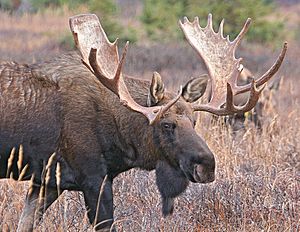Alaska moose facts for kids
Quick facts for kids Alaska moose |
|
|---|---|
 |
|
| Conservation status | |
| Scientific classification |
|
| Kingdom: | Animalia |
| Phylum: | Chordata |
| Class: | Mammalia |
| Order: | Artiodactyla |
| Family: | Cervidae |
| Subfamily: | Capreolinae |
| Genus: | Alces |
| Species: | |
| Subspecies: |
A. a. gigas
|
| Trinomial name | |
| Alces alces gigas Miller, 1899
|
|
The Alaska moose is a huge type of moose. People also call it the Alaskan moose or the giant moose. You can find it in Alaska and western Yukon in Canada. It's the biggest kind of moose in the world!
These moose live in cold, northern forests called boreal forests. They also live in mixed forests with trees that lose their leaves. Alaska moose usually like to be alone. Sometimes, they form small groups. They mostly meet other moose to find a mate. Males and females often look for food in different areas. During the autumn and winter, male Alaska moose can become very protective. They might attack if they feel surprised or threatened.
Contents
What Do Alaska Moose Eat?
Alaska moose eat plants, just like other moose. Their diet includes soft plants and shoots from trees. They especially like willow and birch trees. An Alaska moose needs about 9770 calories every day. That's like eating 32 kilograms (about 70 pounds) of food!
Moose don't have upper front teeth. Instead, they have eight sharp teeth on their lower jaw. They also have a tough tongue, gums, and lips. These help them chew on woody plants.
How Big Are Alaska Moose?
Male Alaska moose are much bigger than females. Males can be 40% heavier! A male Alaska moose can stand over 2.1 m (6.9 ft) tall at the shoulder. They can weigh more than 635 kg (1,400 lb). Their antlers can spread out about 1.8 m (5.9 ft) wide.
The size and shape of antlers depend on many things. These include their genes, what they eat, and how old they are. Antlers help male moose show their strength. This is important for finding a mate.
Female Alaska moose are usually about 1.8 m (5.9 ft) tall at the shoulder. They can weigh close to 478 kg (1,054 lb). The biggest Alaska moose ever recorded was a male. It was shot in western Yukon in 1897. It weighed 820 kg (1,808 lb) and was 2.33 m (7.6 ft) tall. Alaska moose are very large, similar in size to the extinct Irish elk. However, they are smaller than the largest deer ever, called Cervalces latifrons.
How Do Alaska Moose Live and Have Babies?
Alaska moose don't form strong social groups. They usually only meet to mate. Sometimes, two male moose will fight over the right to mate. Male moose are not usually aggressive towards people. But during mating season, they can become very protective. They might attack other animals or even humans if they feel threatened.
Sometimes, fighting male moose can get their antlers tangled. If this happens, both moose could get badly hurt. They might even die from injuries or not being able to eat. However, moose antlers are flat, so they don't get locked together as often as deer antlers.
Male moose make a special mating call to attract females. This call also warns other males to stay away. If a male moose loses a fight, he has to wait until next year to try and mate. Alaska moose mate every year in the autumn and winter. They usually have one or two babies at a time. Young moose, called yearlings, leave their mothers around 10 to 11 months old. Then, they start to live on their own.
Hunting Alaska Moose
People hunt Alaska moose for food and for sport. This usually happens during the fall and winter. Hunters use both firearms and bows to hunt moose.

Images for kids




